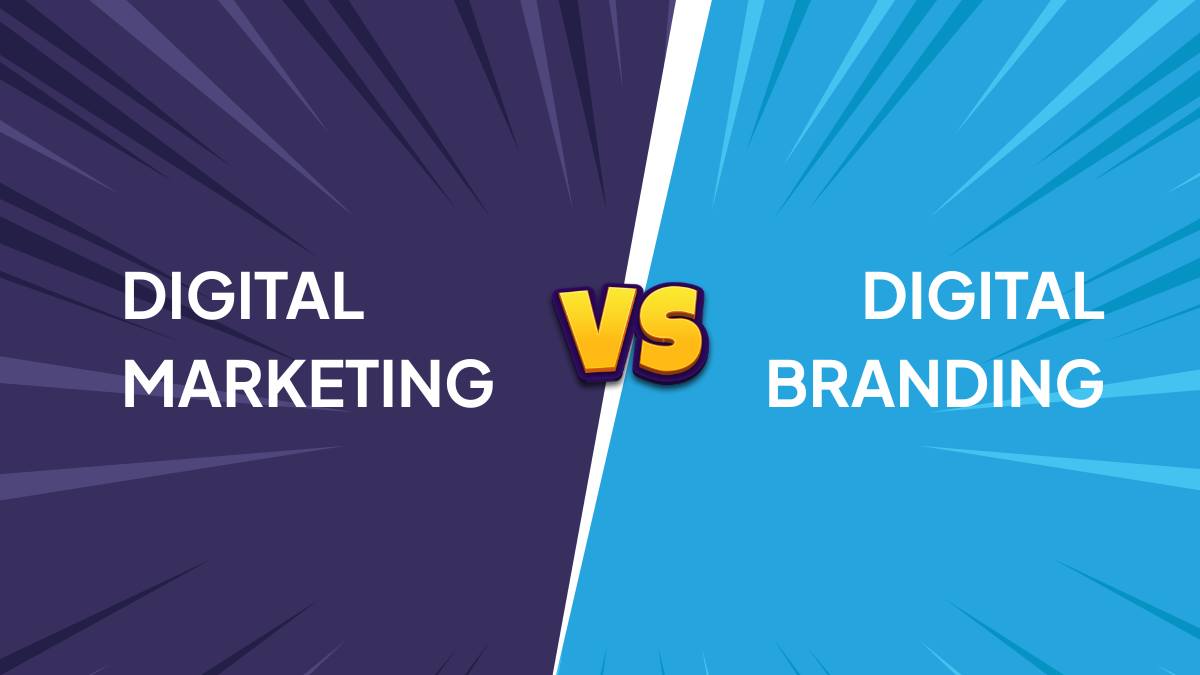There’s a lot of talk about digital marketing vs digital branding, and the two often get mixed up. But the truth is, they’re not the same game. Marketing is about pushing results – getting the clicks, the leads, the sales. Branding is more about what sticks in people’s heads when they think about a business. One is quick impact, the other is long memory. Both matter, but for completely different reasons.
Table of Contents
Introduction
Businesses today are stuck with a strange dilemma. Do they run campaigns that bring customers right away, or do they spend time shaping a brand that might not show results for months – or even years? The problem is that customers have changed. They don’t just see an ad and make a decision. They check reviews, compare products, notice design, and they can tell instantly when something feels off.
Search engines notice too. Companies that only focus on campaigns without building a brand end up paying more for attention. And those that only work on branding often struggle to turn awareness into actual sales. So it’s not really about choosing one side – it’s about figuring out how both connect.
What is Digital Marketing?
Digital marketing is basically the set of tools and tactics used to get attention online and turn it into action. It’s the practical side of things. Campaigns, numbers, dashboards – all that.
Here are some of the main pieces:
- SEO: showing up higher in searches so people actually find you
- Social Media Marketing: running content or ads where people spend their time – Instagram, TikTok, LinkedIn
- Paid Ads (PPC): buying space on Google or Meta to reach the right people fast
- Email Marketing: keeping in touch with people directly in their inbox
- Content Marketing: writing blogs, making videos, sharing guides that pull people in naturally
The strength of digital marketing is that you can see what’s happening almost instantly. A campaign goes live, you track clicks, you tweak, you scale. The downside? Once you stop running it, the results usually dry up just as quickly.
What is Digital Branding?
Branding works differently. It’s slower, harder to measure in the short term, but it’s the reason people remember you. It’s about how your business feels to someone before they ever click “buy.”
Core parts of branding include:
- Visual Identity: the logo, the design, the look that people recognize
- Voice and Tone: how the business sounds when it communicates
- Storytelling: the bigger message behind the product or service
- Consistency: making sure it feels like the same brand wherever people see it – social media, website, ads, anywhere
Branding isn’t about chasing the quick sale. It’s about making sure that when customers are ready to buy, your business is the one that comes to mind first. Campaigns might get traffic, but branding is what decides whether people stay, return, and recommend.
Also Read: Key Functions of Branding in Marketing
Digital Marketing vs Digital Branding: Key Differences
| Aspect | Digital Marketing | Digital Branding |
| Primary Goal | Generate measurable results such as clicks, leads, or sales in a defined period. | Build long-term recognition, trust, and loyalty in the customer’s mind. |
| Nature | Tactical, campaign-driven, focused on performance metrics. | Strategic, identity-driven, focused on perception and consistency. |
| Timeframe | Short-term focus – results can be tracked daily, weekly, or monthly. | Long-term focus – impact grows steadily over months and years. |
| Customer Impact | Influences immediate decisions like “buy now” or “sign up today.” | Shapes how customers feel about the brand, making them choose it repeatedly. |
| Core Activities | SEO, paid ads, social media campaigns, email automation, influencer collaborations. | Storytelling, visual design, brand voice, values, and customer experience consistency. |
| Measurement | ROI, conversions, CTR, CPA, revenue growth. | Brand recall, awareness, loyalty, Net Promoter Score, customer sentiment. |
| Tone | Often persuasive, direct, and focused on solving immediate pain points. | More emotional, narrative-driven, and centered around values and identity. |
| Sustainability | Can deliver fast wins, but results drop when spend or effort stops. | Compounds over time, creating equity that supports marketing efforts. |
| Risk if Ignored | Without marketing, a brand may struggle to reach or convert audiences. | Without branding, campaigns may feel shallow, making retention difficult. |
| Role in Growth | Fuels short-term business growth by capturing opportunities quickly. | Secures long-term growth by making the brand memorable and trusted. |

Enroll Now: Advanced Digital Marketing Course
Why Digital Marketing Needs Digital Branding (and Vice Versa)
1. Branding gives campaigns meaning
A performance ad can bring traffic quickly, but without strong branding behind it, those clicks don’t really go far. People connect with the brand first, then the offer. Branding makes sure marketing campaigns aren’t just attention grabs, but something that creates memory, trust, and a reason for people to come back again.
2. Marketing amplifies branding
Having a beautiful brand story or visual identity is great, but it only works when people actually see it. That’s where marketing kicks in. Ads, content pushes, and email campaigns make sure the story is out there consistently, in front of the right audience, instead of sitting quietly on a website or brochure.
3. They strengthen each other’s weaknesses
Marketing on its own can sometimes feel very transactional – just pushing discounts, clicks, or conversions. Branding alone can feel vague, inspiring but not leading anywhere. Together, they balance each other out: marketing drives the immediate action, while branding builds emotional depth and recognition that ensures customers remember and prefer the brand in the long run.
4. Better ROI through trust
A brand people know and like nearly always sees better marketing results. Familiarity makes customers more willing to click, subscribe, or buy, so cost per acquisition tends to drop. It’s not magic – it’s just that trust reduces hesitation. Marketing spends become more efficient when branding has already laid down the foundation of credibility and comfort.
5. Consistency builds credibility
Digital branding keeps the voice, visuals, and personality of a business aligned across every platform. Digital marketing makes sure that the message doesn’t stay hidden but spreads out to new audiences. When both work together, campaigns don’t just look polished; they feel reliable and consistent, which helps convince customers that the business is professional and trustworthy.
Also Read: Branding vs Marketing
Digital Marketing Strategies vs Digital Branding Strategies
| Aspect | Digital Marketing Strategies | Digital Branding Strategies |
| Objective | Drive leads, sales, and measurable conversions. | Build recognition, trust, and loyalty over time. |
| Nature | Tactical, campaign-based, performance-focused. | Strategic, identity-focused, consistency-driven. |
| Key Channels | Google Ads, Meta Ads, LinkedIn Ads, SEO, email automation, retargeting. | Visual identity, storytelling, social communities, brand voice, thought leadership. |
| Approach | Data-driven decisions, optimized for clicks and ROI. | Narrative-driven, designed to create emotional connection. |
| Timeframe | Short-term results – daily, weekly, monthly. | Long-term results – months, years, brand equity. |
| Measurement | CTR, CPA, ROAS, conversions, revenue growth. | Brand recall, sentiment, loyalty, preference. |
| Customer Impact | Pushes immediate action – buy, sign up, subscribe. | Shapes perception and memory – why customers return. |
| Strength | Fast traction and measurable outcomes. | Sustainable growth and deeper customer relationships. |
| Weakness if Ignored | Sales pipeline slows down or stops. | Campaigns feel transactional and forgettable. |
| When Best Used | Launches, promotions, fast growth phases. | Scaling stage, market positioning, long-term expansion. |
Also Read: What is Brand Marketing?
Digital Marketing vs Digital Branding: Which Should You Focus On?
1. For new businesses
When a business is just starting out, sales often need to come in fast to keep things alive. That’s where digital marketing plays a bigger role. Paid ads, SEO, and email campaigns help bring customers in quickly. Branding matters, but in the early stage, it usually takes a backseat to driving immediate traction and cash flow.
2. For established businesses
Once a company has stable revenue, branding becomes critical for growth that lasts. Strong branding reduces dependency on constant ad spend and builds preference in the customer’s mind. People start to choose the brand not just for the product but for how it makes them feel. That’s what sustains market position and improves long-term loyalty.
3. How budget allocation shifts
The mix between marketing and branding isn’t fixed – it evolves as businesses grow. Startups often allocate most of their spend to campaigns that bring results now, while mature businesses slowly shift more budget into branding. It’s less about choosing one over the other and more about finding the right balance at each stage of growth.
Also Read: Keller’s Brand Equity Model
Conclusion
Digital spaces are only getting noisier, and the gap between businesses that combine marketing with branding versus those that don’t is widening. Marketing makes sure the message reaches people today, but branding is what keeps them coming back tomorrow. One without the other feels lopsided, and customers notice that imbalance faster than ever.
As search engines and platforms get smarter, brands with clear, consistent voices will naturally stand out. Marketing tactics can win the click, but branding is what makes someone remember the name later. The future belongs to businesses that don’t see this as a choice. It’s about balance – fast wins supported by long-term trust.
FAQs: Digital Marketing vs Digital Branding
Is digital branding part of digital marketing?
They overlap, but they’re not identical. Branding is more about the story, the look, the tone – while marketing is the engine that pushes that story out. In simple terms, branding sets the stage, marketing sells the tickets. One can exist without the other, but the results feel half-baked when they’re not working together.
Which is more important for startups: digital marketing or branding?
In the early days, startups usually lean hard on marketing. Cash flow has to come in quickly or nothing else survives. Branding takes time to pay off, but ignoring it altogether can hurt down the road. The smarter play is usually to focus on sales now while slowly layering in branding for the future.
Can you run digital marketing without branding?
Yes, but it rarely ends well. Ads without a recognizable brand behind them just look like noise. People may click once, but they forget fast. Without branding, you’re stuck constantly buying attention instead of earning it. Marketing grabs eyes, branding holds them. Without both, campaigns often cost more and deliver less over time.
How do branding and marketing affect ROI differently?
Marketing ROI is quick and visible – leads, sales, clicks show up right away. Branding ROI creeps in slower, but it multiplies over time. A trusted brand lowers acquisition costs and boosts customer loyalty. In other words, marketing gives the short-term lift, branding builds the long-term runway. Together, they make ROI stronger and steadier.

